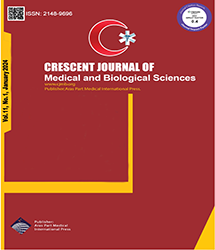
| Original Article | |
| Effect of Remifentanil on Active Phase Duration of Labor in Nulliparous Pregnant Women: A Cross-sectional Study | |
| Fatemeh Mallah1, Hojjat Pourfathi2, Neda Mahmoodieh1 | |
| 1Women’s Reproductive Health Research Center, Obstetrics and Gynecology Department, Tabriz University or Medical Sciences, Tabriz, Iran 2Department of Anesthesia, Tabriz University of Medical Sciences, Tabriz, Iran |
|
|
CJMB 2024; 11: 043-046 DOI: 10.34172/cjmb.2023.3008 Viewed : 2810 times Downloaded : 2458 times. Keywords : Delivery analgesia, Injectable opioids, Remifentanil, Delivery stages |
|
| Full Text(PDF) | Related Articles | |
| Abstract | |
Objectives: Due to the increase in elective cesarean section and its high complications, epidural analgesia is the gold standard for reducing the pain of vaginal delivery. In contraindication cases, other effective and safe analgesic methods such as remifentanil are suggested. The present study aimed to compare the duration of active phase of labor at stages I and II, as well as neonatal Apgar score following the use of remifentanil analgesia. Materials and Methods: In this study, 120 healthy primiparous women who were candidates for vaginal delivery were selected. After matching for age and body mass index (BMI), the participants were assigned into two equal groups (n=60 each) of intervention (receiving remifentanil) and control. We compared the duration of active phase of labor at stages I and II, neonatal Apgar scores, and the cesarean section rate between the groups. Statistical analysis was performed using SPSS software (version 23). Results: There was no statistically significant difference between the two groups in terms of the duration of active phase in the first and second stages of labor (P = 0.84 and P = 0.78, respectively), 1-minute Apgar score (P = 0.95), 5-min Apgar score (P = 0.92), and the rate of cesarean section (P = 0.067). Moreover, we observed no maternal complications with remifentanil. Conclusions: According to our results, remifentanil did not increase the duration of labor, rate of cesarean section, and maternal complications. Hence, it can be a good alternative in cases where epidural analgesia is contraindicated. |
Cite By, Google Scholar
Online Submission System
 CJMB ENDNOTE ® Style
CJMB ENDNOTE ® Style
 Tutorials
Tutorials
 Publication Charge
Medical and Biological Research Center
About Journal
Publication Charge
Medical and Biological Research Center
About Journal
Aras Part Medical International Press Editor-in-Chief
Arash Khaki
Deputy Editor
Zafer Akan



















